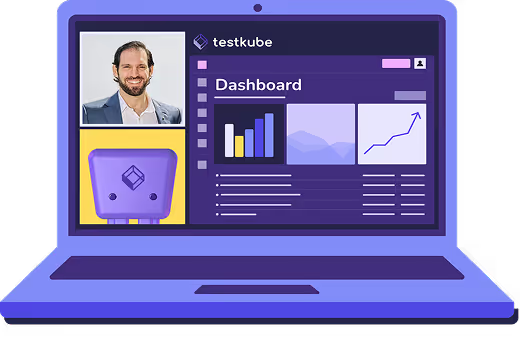

Table of Contents
Try Testkube instantly in our sandbox. No setup needed.
Try Testkube instantly in our sandbox. No setup needed.




Table of Contents
Executive Summary
As organizations adopt DevOps methodologies to accelerate software delivery, the traditional approach to testing has become a bottleneck in the development pipeline. TestOps, or Test Operations, is an emerging strategy that integrates testing seamlessly into the DevOps process, enabling faster and more efficient testing. By embracing TestOps, businesses can ensure that their software is reliable, secure, and performs optimally while meeting the demands of an increasingly competitive market.
The Need for TestOps
As the complexity of modern software applications grows, testing becomes more challenging. Microservices architectures, like those deployed on Kubernetes, introduce unique testing scenarios within the product development pipeline, making it essential to reevaluate traditional testing practices. Addressing these challenges falls under the discipline of test operations, which manages and coordinates testing throughout the software lifecycle. The primary goal of TestOps is to make the test solution scalable and efficient.
To overcome these challenges, TestOps focuses on the following focus areas:
- Streamlining and automating testing processes to keep up with continuous integration and deployment (CI/CD) pipelines.
- Integrating testing activities into the workflow by enabling effective collaboration between testers, developers, and operations teams to ensure seamless communication and shared responsibility.
- Monitoring and analyzing test results continuously for better decision-making and rapid feedback.
TestOps and Test Automation Components
TestOps revolves around several key components that enable a smooth transition from traditional testing to a more agile, collaborative, and efficient approach:
Test Automation
TestOps emphasizes automating repetitive and time-consuming tasks, such as regression and smoke tests. By integrating comprehensive testing frameworks and leveraging all available testing tools, teams ensure complete test coverage and support scalable automation. As codebases grow and complexity increases, automation testing becomes a core discipline requiring structured quality processes, robust management systems, and scalable solutions. Both functional and non-functional testing are crucial for evaluating performance, security, and other quality attributes.
Continuous Testing
TestOps integrates testing into every stage of the development lifecycle, from code commits to deployment. By continuously running tests as an ongoing activity, teams ensure thorough code testing before release. This approach enables early detection and resolution of issues, reducing the risk of production failures and improving overall software quality.
Collaboration & Ownership
TestOps encourages close collaboration between developers, testers, operations teams, and product owners through centralized platforms that facilitate test lifecycle management and real-time visibility. QA engineers take full ownership of testing processes, including planning, management, and control activities. DevOps integration ensures seamless workflows, while standardized control processes and naming conventions organize tests for clarity and consistency. Quality assurance remains a central focus throughout the entire process.
Test Environment Management
TestOps requires the ability to quickly spin up, tear down, and manage test environments that closely mirror production conditions. This capability ensures tests run under realistic scenarios, making discovered issues relevant to the production environment and supporting effective test management.
Monitoring & Analytics
TestOps relies on continuous monitoring of test results and application performance to provide rapid feedback for data-driven decisions. Failure diagnostics analyze test results to inform process improvements, while analytics assess release readiness and team effectiveness.
Benefits of TestOps
Adopting TestOps brings a host of benefits that transform the way organizations approach software testing. By embedding testing processes throughout the software development lifecycle, teams can detect and resolve issues earlier, leading to higher test coverage and greater test stability. This proactive approach not only reduces the cost and effort associated with late-stage defect fixes but also ensures that software quality remains consistently high from development through to release.
TestOps fosters a culture of collaboration between development, testing, and operations teams, aligning everyone towards the shared goal of delivering high quality software at a faster pace. With real-time visibility into testing activities and results, teams are empowered to make data-driven decisions that optimize their testing strategies and maximize efficiency. Continuous improvement becomes a natural part of the workflow, as insights from each development cycle feed back into refining testing processes. Ultimately, TestOps enables organizations to accelerate delivery, improve overall software quality, and maintain a competitive edge in today’s fast-paced software development landscape.
Challenges and Solutions in TestOps
Implementing TestOps in a Kubernetes environment can present several challenges, such as managing complex CI/CD pipelines, storing test results, determining when to run specific tests, and retriggering tests without rerunning the entire pipeline. However, there are solutions and best practices that can help address these challenges:
- Adopt cloud-native testing tools: Use tools specifically designed for Kubernetes and cloud-native environments, such as Testkube, to streamline testing processes and reduce complexity.
- Store test results in a centralized location: Utilize artifact storage solutions to store and manage test results, videos, and screenshots, ensuring easy access and better visibility into test outcomes.
- Implement a test scheduling strategy: Determine which tests should be run at each stage of the development pipeline and establish triggers or schedules for running compute-intensive
Artificial Intelligence in TestOps
Artificial intelligence is revolutionizing TestOps by automating and optimizing every aspect of the testing process. AI-powered testing tools analyze vast amounts of test data, uncovering patterns and predicting potential issues before they impact the product. This predictive capability allows teams to focus their efforts on the most critical testing activities, improving both efficiency and effectiveness.
AI addresses one of TestOps' most persistent challenges: flaky tests that undermine stability and slow development pipelines. By automatically detecting unreliable tests and suggesting targeted fixes, AI maintains the integrity of automated testing and ensures trustworthy results. Beyond stability, AI streamlines test planning, automates execution, and provides intelligent analysis of results, freeing QA engineers to concentrate on higher-value strategic tasks.
The integration of artificial intelligence in TestOps accelerates high-quality software delivery while enabling teams to continuously improve their processes and adapt to evolving development demands.
Best Practices for TestOps
Integration-First Approach
Integrate testing into every phase of the software development lifecycle to ensure quality is built in from the start, not added as an afterthought. This foundational approach prevents quality issues from accumulating and reduces downstream costs.
Automation Priority
Prioritize automated testing wherever possible, utilizing robust tools and frameworks to streamline repetitive tasks and increase test coverage. Focus automation efforts on high-impact areas like regression testing and critical user journeys.
Continuous Improvement Culture
Regularly review testing processes, analyze outcomes, and implement changes that enhance efficiency and effectiveness. Establish feedback loops that capture lessons learned and drive iterative improvements.
Strategic Test Planning
Ensure test cases are well-defined, relevant, and aligned with project goals. Effective planning reduces waste and maximizes the value of testing efforts.
Cross-Functional Collaboration
Foster collaboration among testing teams, developers, and operations to break down silos and ensure everyone is invested in delivering reliable, high-quality software.
Implementation Strategy
- Phase 1 - Assessment and Planning: Begin by evaluating current testing processes to identify strengths, weaknesses, and improvement opportunities. Define a clear TestOps strategy that outlines the tools, frameworks, and methodologies best suited to your organization's specific needs and constraints.
- Phase 2 - Tool Integration and Automation: Emphasize automated testing adoption and ensure chosen tools integrate seamlessly with existing development pipelines. Establish robust CI/CD pipelines to embed testing into every stage of the software development lifecycle, making testing an ongoing activity rather than a separate phase.
- Phase 3 - Monitoring and Optimization: Regularly monitor testing activities and analyze results to identify trends, bottlenecks, and optimization opportunities. Use data-driven insights to continuously refine processes and leverage the right tools for maximum impact.
Success Outcomes
By following this structured approach, teams achieve greater efficiency, reduce defect risk, and consistently deliver high-quality software. Proper TestOps implementation empowers organizations to keep pace with modern software development demands while maintaining a strong focus on overall quality.
The Future of TestOps
TestOps is a crucial strategy for organizations looking to improve the speed and efficiency of their testing processes. By automating testing, collaborating effectively, and continuously monitoring and analyzing results, businesses can ensure the reliability and performance of their software while meeting the demands of a competitive market. As organizations continue to adopt DevOps methodologies, TestOps will become even more critical for success in software development and delivery.


About Testkube
Testkube is a cloud-native continuous testing platform for Kubernetes. It runs tests directly in your clusters, works with any CI/CD system, and supports every testing tool your team uses. By removing CI/CD bottlenecks, Testkube helps teams ship faster with confidence.
Explore the sandbox to see Testkube in action.



.avif)